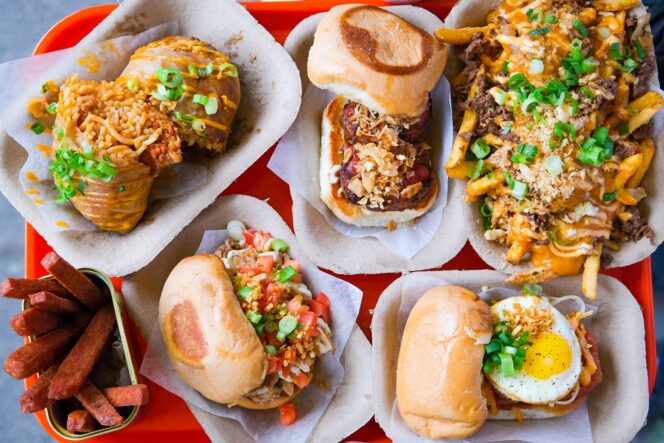
Halo-halo; sourced from Max’s Restaurant
Vancouver has developed an international reputation for its varied and exceptionally high-quality Asian restaurants. However, one delicious cuisine has yet to receive the attention it deserves, until now.
April will be the inaugural Filipino Restaurant Month, which is occurring across Canada. It’s an initiative that has emerged from a collaboration between the Philippine Embassy in Ottawa, the Philippine Consulates General in Vancouver, Calgary, and Toronto and the Philippine Department of Tourism. Forty restaurants will be officially participating, including ones in the Lower Mainland, such as Pampanga’s Cuisine and Kumare in Richmond and Delta.
Max’s Restaurant eagerly agreed to take part because they felt it was important to raise the profile of Filipino food establishments in Vancouver. “All the other Asian cuisines, we know all of them out there. Filipino cuisine is not known as much,” says Cecile Pratt, managing director. Max’s also takes part in Dine Out Vancouver because they’re on a mission to share more broadly what makes Filipino cuisine well worth appreciating.
They’ll be offering a special three-course dinner menu for $30 from April 19 to April 30. Diners will first choose between lumpiang Shanghai (spring rolls), calamares (calamari), and Max’s fried chicken wings. There will be five entrée selections, including BBQ pork skewers with pancit palabok (rice noodles), sizzling tofu with rice, and boneless chicken inasal (grilled marinated chicken). Dessert will be either mais con yelo (sweet corn with shaved ice, milk, and ice cream) or saba con yelo (banana).

BBQ pork skewers; photo sourced from Max’s Restaurant
Pratt believes Max’s Restaurant is a great representative of Filipino cuisine because of the longevity of the brand. Since its inception in 1945, the restaurant has become a household name within the Philippines and within the Filipino diasporic community. Max’s Restaurant and the recently opening of Jollibee in Vancouver evidence a growing of phenomenon of Filipino chains expanding globally.
Asked what makes people new to Filipino cuisine fall in love with it, Pratt responds: “People come to enjoy the taste of the food and the hospitality of our people. The food is unique and different.” She says because of the Philippines’ long history of colonialism, its food is a hybrid of many different culinary influences, including Spanish, Chinese, and American.
Besides Max’s signature fried chicken, Pratt recommends some classic Filipino dishes for developing an appreciation of the cuisine. Their crispy pata (pork hock) served with a soy-vinegar dipping sauce is a must, as is the very comforting and richly flavourful kare-kare (beef shank and oxtail with vegetables in a thick peanut sauce). Meanwhile, the savoury tang of the pinatuyong pork adobo makes it popular. And for dessert, it’s impossible to say no to their special halo-halo, with tropical preserved fruit, beans, milk, shaved ice, ube ice cream, banana, cheese, and rice flakes.

Crispy pata; sourced from Max’s Restaurant
Filipino Restaurant Month is an invitation to try the many Filipino restaurants in Vancouver. In 2009, Rose Samaniego left her long-standing job with an investment company to open her first location of Kulinarya in Coquitlam because she wanted to pursue her passion for Filipino cuisine. It was so well received that she opened a second location on Commercial Drive. “We’re offering traditional Filipino food that is very special to me. This is a menu that I created that I would like to share with the community. These are dishes that I grew up eating and that I make for my kids,” she says. She was inspired by her grandmother’s cooking as she refined her recipes, wanting to capture the Filipino comfort food usually only available to insiders.

Kamayan feast at Kulinarya; photo sourced from Culinary
She says that misperceptions and a a general lack of knowledge of Filipino cuisine exist but are quickly overcome once people try the food. “People should be not be afraid of Filipino food. We have so much to offer. It’s not just turo-turo [translates to point and point to refer to fast food-style joints]. We have so much fresh, amazing food,” she says. Especially with recent supply chain issues, Samaniego has been using more local ingredients in her traditional dishes.
Sought after dishes at Kulinarya include their kare-kare, crispy pata, as well as ginataang kalabasa, which consists of green beans, squash, and eggplant in coconut milk. This vegetarian dish is especially popular at their Commercial Drive location, while diners at the Coquitlam restaurant love the lechon kawali (pork belly with lechon sauce). People also come for their all day almusal (breakfast), such as a dish with fried boneless bangus (milkfish) served with garlic rice, two eggs, house-made relish, tomato, and cucumber.

Breakfast bilao (tray): longganisa, daing na bangus, beef tapa, garlic fried rice and eggs; photo sourced from Kulinarya
Samaniego says that although chefs have been predicting Filipino cuisine as the next big thing, she says it’s still not broken through into the collective dining consciousness. “It’s not like we’re mainstream. I think we’re far from it,” she says. She feels this lag is partially because the Filipino culture is less focused on dining out, and because the Filipino community in Vancouver has not gravitated to opening restaurants. However, Samaniego is optimistic that establishments like Kulinarya will make Filipino cuisine more accessible to those who haven’t tried it yet. She also sees a shift in the next generation. “I’m working with a lot of young chefs who hope to have their own Filipino restaurants,” she says.
One representative of this new generation is Corvette Romero, who opened a food truck and now a brick-and-mortar location called Shameless Buns with her partner Matt Brennan. The couple chose the name for their food business because of their unabashed affection for Filipino cuisine and their desire to promote it whenever and wherever they can. “There are not a lot of hip, cool, trendy Filipino restaurants,” Romero says. While she adores the traditional Filipino food that she ate while growing up, she also sees room for interpretations of the cuisine that are more playful and broadly connective.

Corvette Romero and Matt Brennan; Sourced from Shameless Buns
Brennan was immediately intrigued by and hooked on Filipino food when Romero introduced him to it. “As someone who loves food and is very curious about food, I was fascinated by the cuisine, which was really unlike anything I had ever experienced before. As I learned more about the cuisine and started cooking it, we starting thinking that we needed to make it more approachable,” he says. Brennan highlights the unexpected ingredient and flavour combinations, and the unique confluence of cultural influences, that make Filipino cooking so exciting for him.
The couple’s main offering is their buns, basically pandesal (Filipino sweet, fluffy rolls) filled with their takes on classic Filipino ingredients, such as chicken adobo, longaniza (sweet and spicy pork sausage), and embutido (meatloaf). Tasty condiments such as sriracha mayo and garlic calamansi aioli heighten the flavour experience. The buns can be ordered with inventive sides, like lumpia (spring rolls) filled with sweet Filipino spaghetti or cheeze steak fries with crispy palabok fries, tapa (marinated beef), caramelized onions, chipotle cheeze sauce, chicharron, sriracha mayo, and green onion.

Sourced from Shameless Buns
“We want to pay homage to the Philippines but we also want to do it in a really cheeky and playful and fun way. The food is very visually appealing as well, very colourful. It’s almost like our interpretation of Filipino culture summed up in our food,” says Brennan. The duo see themselves as part of a Filipino movement fuelled by a younger generation rediscovering their culture and modernizing the cuisine within a Western context. And they think that non-Filipinos are definitely starting to take notice.

Filipino spaghetti lumpia; photo sourced from Shameless Buns
“We’re actually super exited that Jollibee is here because people are finally talking about Filipino food,” Romero says. She says all this conversation about the Filipino chain opens the door for other Filipino restaurants in town to attract diners to their offerings. “There’s so much hype about it that it piques people’s interest to try Filipino food. Almost always people try our food and love it,” she says.
The couple have plans to keep expanding the offerings on their menu. At the restaurant, they added ice candy in rotating flavours and Corny Pinoy (elote), which consists of toasted corn, garlic calamansi aioli, salted egg, red onion, chicharron, feta, and cilantro. They also recently won People’s Choice Award in the Vancouver Foodster 2022 Poutine Challenge with their limited feature Manila fries with palabok fries, lechon with crackling, cheese curds, and mang tomas gravy. In the future, they dream of opening Shameless Buns locations beyond Vancouver, in places like Los Angeles or New York.

Ice candy; photo sourced from Shameless Buns
Romero is incredibly proud of her Filipino culture and its cuisine. “I’ve always been in touch with my Filipino roots. My grandma, my lola, was a great cook and I watched her cook from when I was a little kid,” she says. Opening Shameless Buns has helped her connect with other Filipino food entrepreneurs. Once a year, just before the December holidays, she and Brennan organize Magkasama Market as a way of bringing Filipino vendors together and sharing the culture with the city. Romero and Brennan ultimately want to spread the word: Vancouver has a vibrant Filipino food scene, just waiting to be discovered and enjoyed.
















